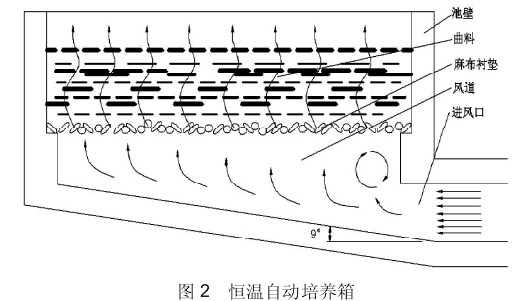In recent years, electrothermal temperature incubators have been widely used in the winemaking and soy sauce production industries, but there have been major deficiencies regarding the uniformity of air flow, the stability of flow velocity, and the determination of air volume. Therefore, it is necessary to conduct preliminary research on the above-mentioned problems in the electrothermal incubator in order to guide production with better methods. 1 Uniform and stable cabinet flow R&D The original box structure shown in Fig. 1 is known from the knowledge of aerodynamics. When the lower layer adopts flat-bottom design, it may lead to: (1) insufficient air pressure at the end of the culture tank; (2) dead corner of ventilation; (3) uneven flow rate The flow rate is not stable. For the insufficiency of the original design, the project adopts a box design as shown in Fig. 2. The wind deflector tilts (about 10°) to increase the wind pressure at the end of the culture tank, remove the dead angle of ventilation, and make the ventilation more uniform. During work, due to the obstruction of the wind to the wind, the airflow creates static pressure in the tank. Under the influence of the difference between the pressure of the bottom layer of the melody and the top layer, a stable flow of fresh air through the vortex is created and excess heat is removed. 2 Determination of wind pressure and flow in project design 2.1 Wind pressure According to relevant data, the resistance constant of Aspergillus oryzae was introduced. Considering that Rhizopus culture process is similar to the culture process of Aspergillus oryzae, the Rhizopus culture resistance constant is still selected as mm water column/cm thick, and the incubator design has a thickness of 25 cm, so it needs wind. Pressure, but also need to consider a certain margin. 2.2 Required air volume According to related data, during the culture process, the amount of starch consumed accounts for 14% of the input of bran, and 100 kg of input rhizome. The total consumption of starch for each box is. Consumption of 1kg of starch releases heat of 17388.8kJ. The total amount of heat released from each box is calculated based on the ventilation of the box for 12 hours. The average heat released per hour is. The required air volume Li2-i1, where L is the weight of the required air, q is the average amount of heat released per hour, i1 is the bake value when the air enters the box, and i2 is the value of the air when the air leaves the curved layer. When the air inlet temperature is 24°C and the relative humidity is 85%, look-up table i1=75 (kJ/kg), the air leaves the song layer temperature 37°C, and the relative humidity 100, check the table i2=144(kJ/kg). Then L = 20287144-75 = 294, air bulk density = 1.2 (kg/m3), then L = (m3 / h). Considering that when the general factory selects the fan, the air volume will be selected as the average value, so the air volume needs to be 500m3/h. 3 Conclusion Through the research and improvement of the project, the uniform distribution of wind in the ventilation system was achieved. In the production practice can achieve more efficient, high-quality koji. In addition, the thermostatic chamber technology developed by the project can be extended to a constant-temperature culture pool, and its sealing performance is further improved. Quchu's manufacturing cost is reduced and it can be better adapted to production needs. Related Instruments: Soil Crusher Plant Crusher Cnc Machining,Plastic Machining,Heavy Machining SOMAX ENTERPRISE CO., LTD. , http://www.tzdiecast.com
